Are you interested in keeping the Frogspawn coral in a saltwater aquarium, but aren’t sure if it is hard to keep, where to put it, or how quickly it will even grow? Let’s dive right into some tips about Frogspawn coral care, and answer some of your questions.
Table of contents:
Frogspawn coral care
The key to successful Frogspawn coral care in a saltwater aquarium is to provide the coral with aquarium conditions that will help it thrive. There are three key areas to focus your efforts:
- Water chemistry
- Proper placement to provide sufficient water flow and light
- Feeding
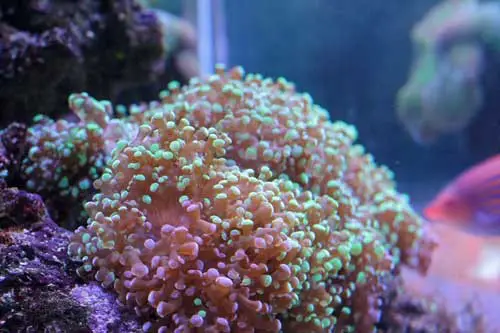
Water chemistry needed for Frogspawn coral care
In order to provide adequate Frogspawn coral care, you have to create and maintain stable reef tank water parameters. The short version here is that you need to maintain a stable:
- Temperature: 78-82 degrees Fahrenheit (25.5-27.8 C)
- pH: 8.2
- Alkalinity: 8-12
- Calcium: 400 ppm
- Salinity(measured as specific gravity): 1.025
- Ammonia, nitrates, and nitrites = 0
Proper placement for Frogspawn coral care provides sufficient water flow and light
In the ocean, water currents, waves, and tides bring oxygen, food, and nutrients to all coral types, while sweeping away waste. The sun provides the perfect light to sustain growth. In a saltwater aquarium, we have to recreate those conditions. Aquarium pumps and powerheads are used to create life-sustaining water flow and LED lights are generally used to replace the sun.
The Frog spawn coral isn’t able to move itself to the best location in your tank, you have to pick the location for it, and the ideal placement is going to be different, from one aquarium to another. The key is to think like Goldilocks–not the breaking-and-entering part, but the part about not providing too much or too little of a good thing.
Water flow
The ideal Frogspawn coral placement is going to have moderate water flow–too much flow and the coral polyps will retract (and might get damaged or tear). Too little flow won’t provide enough oxygen for strong growth.
Light
Proper Frogspawn coral care requires you to provide moderate light. They will bleach under intense lighting and will starve under low levels of lighting.
A final thought on placement
If you have strong reef lighting, the best placement is typically towards the bottom of the tank, on or near the substrate, and off to the side or outer perimeter of the aquarium light. If you have a small nano aquarium with relatively weak LED lights, you may need the coral to be closer to the middle, to receive adequate light. And as mentioned before, that same area should have moderate flow, provided by a gyre pump or a powerhead.
Another important element of the ideal coral placement is to ensure adequate space between your Frogspawn coral and other corals in the aquarium.
Sweeping stings
Sweeper tentacles are an issue with the Frogspawn coral. It is a relatively aggressive coral and the sweeper tentacles pack a sting and will damage nearby corals.
Sweeper tentacles can get along with this species, so it is best to give the frogspawn coral a wide berth–like 6 inches on every side–to be safe. If you cheat and try to stack other corals too close to the Frogspawn coral, you will regret it, because the coral will simply burn its way into the aquascape.
The biggest challenge with caring for the frogspawn coral–Euphyllia divisa–is the 6-inches rule
That reminds me of a game we played as kids. Did anyone else play a barbaric game as a kid called 6-inches?
If you want to properly care for this and other corals, you should place all other corals at least 6 inches away from the Frogspawn at any given time…that means when you newly place the frag in your tank…one year down the road and 3 years down the road, too, when all the corals are growing together. Yikes.

The one exception to this rule is with other similar Euphyllia species, like the anchor and torch corals, which should not be damaged by the sweeper tentacle of a neighboring colony. So if you can at all manage it, try to put other similar species nearby. Here’s a tip I picked up in Borneman’s book, Aquarium Corals:
To keep the formation of sweeper tentacles down, avoid placing these corals in a spot with exceptionally fast water flow.
Acclimation
Acclimation is going to be key. Even if you have the perfect place for your new coral. It might not be perfect right away. If there is significantly more or less intense lighting or dramatically more or less water flow, the change might stress your coral. Too much stress and the coral could bleach and die, or just die. So it is typically best to scale back your aquarium lights and gradually increase the intensity to help your coral better acclimate to the conditions in your saltwater aquarium.
Feeding
The Frogspawn coral, like all corals, is an animal–and animals need to eat. That can be confusing, sometimes, when thinking about corals, because we buy expensive aquarium lights, to provide an energy source for them.
But the corals are not plants, they are animals, that ‘house’ tiny organisms called zooxanthellae. These zooxanthellae are the creatures that harness the light power to make sugars–and they do provide a fair amount of the nutrition for the coral, but it is still generally best for you to feed your frogspawn, in addition to providing it with adequate light.
The technique used generally is called ‘spot feeding’. That’s where you take a device like the Sea Squirt or Julian’s Thing and drop some small, meaty foods on the polyps. The key or the ‘trick’ here is to match the food particle size with what the coral wants to eat, which takes some trial and error sometimes.
There are also hobbyists who report success feeding tiny pellets, although I have not personally had success with this.
Are Frogspawn corals hard to keep?
Frogspawn corals are hardy and attractive LPS species that are relatively easy to care for, by coral standards, if the proper aquarium conditions are provided for.
Varieties of Frogspawn coral
There are actually two different species of Frogspawn coral that are somewhat commonly kept in the saltwater aquarium hobby. The most common species has the scientific name Euphyllia paradivisa. Euphyllia is the genus that contains Hammer corals and Torch corals, and the other species of Frogspawn coral, named Euphyllia divisia.
E. paradivisa grows as clusters of small, thin branches (like a coral bouquet) and E. divisa grows as a single-walled coral. E. paradivisa is easier to frag and therefore frags are more commonly available and therefore I would consider it more popular.
You will find that certain local fish stores or online stores may also categorize them by their color: blue or green, for example. The more exotic the color morph, the more expensive the coral is, generally speaking, although coloration is also influenced by the lighting spectrum used.
Problems encountered during Frogspawn coral care
As mentioned earlier, the Frogspawn coral is a hardy LPS species. They don’t tend to have a lot of problems in the home aquarium. The biggest issues to prepare for in Frogspawn coral care :
- Aggression between coral species
- Polyps being nipped by a not-so-reef-safe saltwater fish
- Polyps not opening-up
- Physical damage due to handling
- Brown jelly infections
- Bleaching
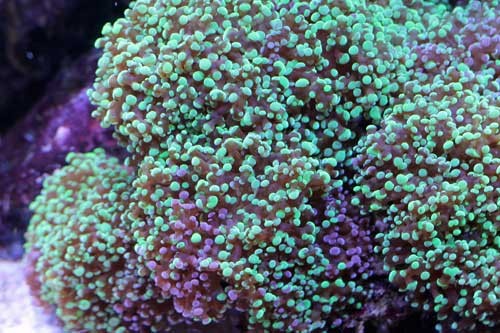
Aggression between coral species
Life as a coral must be tough. They are at the mercy of their environment and surroundings. But that doesn’t mean they are pushovers. Corals have adapted very sophisticated ways to protect themselves from competitors in their environments. Some corals and algae release chemicals, others attempt to grow over and shade out, and many, including the Frogspawn coral, try to sting their neighbors into submission. If you see damage at the border polyps between different species, you may have an issue with aggression.
The best bet, sometimes, is to trim back, or frag the corals, and/or relocate the colony or frags, to create more space.
Polyps being nipped by a not-so-reef-safe-saltwater fish
Occasionally, aquarium owners have one of those ‘usually reef safe’ fish species, that do nip at coral polyps enough to disturb the Frog spawn coral. If the nipping is aggressive enough, the coral frag may not extend its polyps, and trouble can result from that. The remedy here is to identify the problem and isolate the offending fish.
Polyps not opening-up
If Euphyllia divisa polyps aren’t expanded, it is certainly a sign that something is wrong. Check to make sure nothing is physically disturbing your coral (like a clownfish that wants the coral to be an anemone or a butterflyfish or angelfish with a polyp-nipping habit.
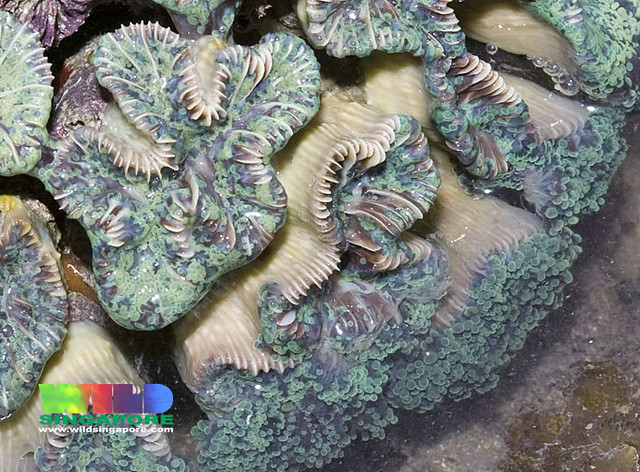
Please also check the water flow and water parameters. Remember the Goldilocks principle with respect to water flow and ensure the reef aquarium water parameters are stable. If the polyps are retracted, this may be a bellwether of less than ideal water conditions. Check those last entries in your reef journal and look for changing water parameters.
Sometimes, performing a simple water change can help get the water conditions back on track.
Physical damage due to handling
The large, fleshy polyps of LPS corals like the Frog spawn are prone to damage. You must be extremely careful when handling them, moving them, adjusting live rock nearby–and be careful to ensure that water flow is appropriate, or the polyps might tear.
Brown jelly infections
The Frogspawn coral is prone to brown jelly infections. A brown jelly infection tends to be the result of two factors: physical damage to the coral, followed by the opportunistic infection with a protozoan or other disease agent that causes the rapid loss of polyps, and often, the entire colony (Borneman 2001).
Bleaching
Corals that are severely stressed by some environmental queue, like perhaps being put too directly under the white-hot aquarium lights, may undergo bleaching–which is where the coral expels the photosynthetic symbiotic zooxanthellae. Depending on how serious the bleaching and stress are, the coral can sometimes be nursed back, or you may lose the entire Frog spawn coral colony.
The Frogspawn coral is prone to brown jelly infections.
Brown jelly infections are a serious problem that can be encountered when keeping the Frogspawn coral. Typically, the first thing that happens is some sort of trauma or damage to the coral polyps themselves. The injured coral is then thought to be subjected to a protozoan infection–and those protozoans turn the polyps into a gross-smelling, disgusting-looking brown jelly (Borneman 2001).
Brown jelly infections spread quickly across the whole coral, often killing the entire coral colony. I am not a veterinarian, but the advice I’ve seen when treating this condition is along the lines of ‘amputation’. You need to remove the colony from the water and then cut away or frag any infected areas and some of the bordering healthy areas, allowing the coral to recover in isolation, to be sure the infection doesn’t spread.
Frogspawn coral care: how to frag
The branching variety of frogspawn coral, Euphyllia paradivisa, is fragged fairly easily by snapping, cutting, or sawing the branches near the base and using cyanoacrylate glue to affix the frag to your preferred piece of live rock.
What to read next
Check out a few of these other equally awesome and perhaps even more popular LPS coral types:
or find an entirely new coral type, Zoanthids or Mushrooms
Please also sign up for the FREE Saltwater Aquarium Blog Newsletter.
References:
Borneman, Eric H. Aquarium Corals. Microcosm Ltd; 1st Printing Edition (March 1, 2001)
Ulrich III, Albert B. How to Frag Corals: Step-by-step guide to coral propagation and filling your frag tank with thriving polyps.www.SaltwaterAquariumBlog.com (January 20, 2015).
Ulrich III, Albert B. The New Saltwater Aquarium Guide.www.SaltwaterAquariumBlog.com (April 8, 2014)



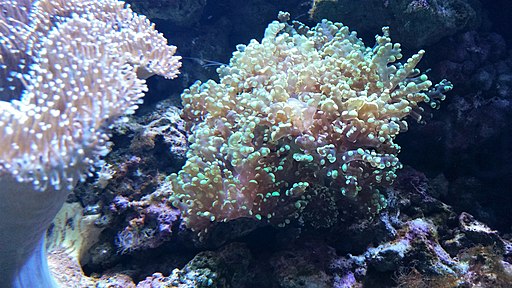
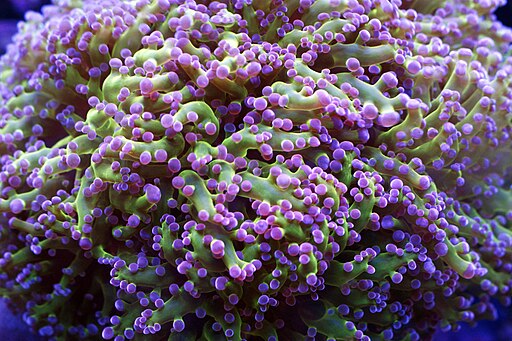

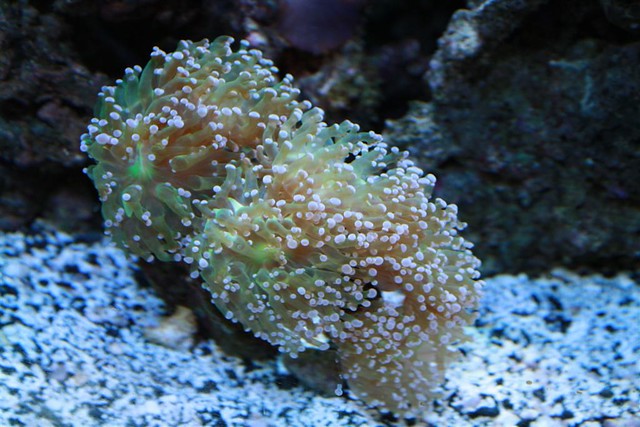

Leave a Reply